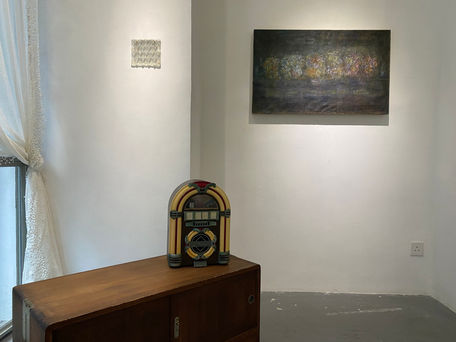Life on earth turns out quite cheap.
For dreams for instance you don’t pay a penny.
For illusions—only when they’re lost.
——Here by Wisława Szymborska
Dallas Lee's solo exhibition Here is named after Wisława Szymborska's poem, which is a metaphor for the worldview she constructs during her creative process. She invites audiences to enter into her imaginary space and wander through various fictional images, hoping that they can take away some fragments of the dreamland piled up by the artist, and visualize their scenarios. See the mind with the mind is an extension of her graduation series of the same name, looking back on her development over the past three years, and continues to explore and depict the objects that she is fascinated by with the concepts of Buddhism, as well as reconfiguring them to create fictional spaces and scenes in her paintings.
“Objects of perception are merely manifestations of consciousness.” originates from Buddhist philosophy, mere-consciousness, which refers to the fact that all things in the world are realized by the eight senses, and there is no objective object or external realm. This notion has always been the basis of Lee's creation, believing in the subjectivity of the object, observing the state of the object itself, and considering the relationship between the object and herself. In the process of painting, she captures the flow of time and state, as well as the remnants of her impression of the object, and then paints the sweet imaginary world of the artist's fantasy by looking at it through her mind's eye.
In Dallas Lee's works, objects and space are the most important elements. Most of the recurring objects in her paintings are projections of the artist's desires, as well as a delay in the habit of rapid consumption. The emotion of obsession is transformed in the process of multiple depictions, from a sense of novelty to a more permanent sense of attachment and familiarity, which then provokes the desire to constantly repaint the same objects. The concept of mere-consciousness is always back to oneself, and it takes practice to follow intuition and to keep talking to oneself through the desire for the object, to sort out how the mirror of the mind reflects the external world.
The artist believes that when she believes in something, it will happen. Through painting, she can travel freely between reality and the imagination, she takes painting as the action to fill in the imperfections she feels in the current state of affairs. In the process of creating a wonderland, she also creates a respite for herself, a place to escape from reality. The world of her imagination is too beautiful, and whenever she returns to reality, she will always feel dismayed and disappointed. Therefore, she keeps looking at herself in the process of creation and learns to accept reality in the process of dialoguing and spending time with herself, which even brings her the strength to face life. She believes very firmly that the perception that painting brings to her has already become an instinctive existence, and it is something that she can do for a lifetime.
In her approach to painting, the artist tends towards intuitively deciding on the composition and forming her distinctive patterns and logic. She draws from places she has visited before, deletes the parts that are too familiar, and then uses her imagination to modify the original space before placing the objects into the painting. In the process of creation, the artist mostly uses her feelings and intuition to respond to the external objects and memories of the paintings, so that even after the paintings are completed, every time she looks back at them, she can still recall the memories of the time, and it is also a record for herself. At the same time, the artist also hopes to evoke a sense of empathy in the audience through her works, and the objects appear repeatedly in different paintings, thus becoming specific symbols.
In addition to the paintings, the exhibition also showcases objects that the artist has often painted or been inspired by. These objects are scattered in the exhibition, some of them are placed individually, while some of them give the clue to constructing a new scene, inviting the audience to enter the world of the artist's fantasies and to freely organize a space of imagination that belongs to the intimate nature of each individual. As Wisława Szymborska's poem says, for dreams for instance you don't pay a penny, and as long as the illusion remains unbroken, there is no cost. A fairyland is awaiting, welcoming you Here.
Curatorial statement by Kobe Ko










